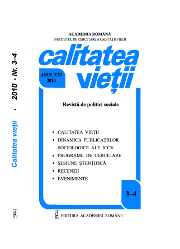Structurile latente ale distanţei sociale
Latent structures of social distance
Author(s): Cornelia RadaSubject(s): Social Sciences
Published by: Editura Academiei Române
Keywords: latent classes; factorial analysis; social distance.
Summary/Abstract: The goal of this paper is to bring solid arguments for the latent class analysis use as a research tool in the social and behaviour sciences. I started with a technical presentation of the latent class analysis method, limited to what is strictly necessary for the basic understanding and subsequently, continuing with a practical research example. Using the Latent Gold software aimed to identify patterns of the social distance expressed by the whish not to have as neighbours 11 socially stigmatized person categories as drug addicts, immigrants, Roma people, ex convicts, etc. The analyzed data have been provided by Soros Foundation Romania and are part of the Public Opinion Barometer, October 2007. The initial 11 items set was split up into two subsets, using a special form of factorial analysis technique with continuous latent components, which have been later explored using latent classes cluster analysis. For the first variables subset, a four latent classes model was identified as the best fit and for the second variables subset, a three latent classes model was identified as the bets fit. In the intolerant and distant clusters prevail women and people from rural areas. However, the women are more likely to accept HIV infected neighbors and the people from rural areas are more tolerant with Roma people. In the tolerant and tolerant with Roma people, the men prevail. In the urban areas, the tolerance for HIV infected neighbors is higher. The people with high educational level are predominant in the cluster HIV-tolerant, but they are distant in respect to drugs or alcohol addicted people.
Journal: Calitatea vieţii
- Issue Year: XXII/2011
- Issue No: 1
- Page Range: 60-82
- Page Count: 23
- Language: Romanian

